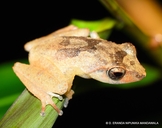|
Pseudophilautus schneideri Meegaskumbura & Manamendra-Arachchi, 2011
| family: Rhacophoridae subfamily: Rhacophorinae genus: Pseudophilautus |
| Species Description: Meegaskumbura M, Manamendra-Arachchi K 2011 Two new species of shrub frogs (Rhacophoridae: Pseudophilautus) from Sri Lanka. Zootaxa 2747:1-18. | |
 © 2019 Dayupathi Eranda Nipunika Mandawala (1 of 6) |
|
|
|
Description Color in life: Head dorsally light brown, laterally dark brown. Supratympanic area, upper tympanum and interorbital area black. Mid-dorsum dark brown with tiny black and dark brown spots. Both upper and lower areas of flank pale brown with dark-brown spots. Inguinal area yellowish brown with dark-brown spots. Dorsal and lateral parts of limbs pale brown with dark-brown spots. Lower arm with one, thigh with three and shank with three dark-brown crossbars. Fingers and toes pale yellowish brown with dark-brown pigments. Outer edge of ventral side of foot dark brown. Ventral side of foot pale yellowish brown with dark-brown patches. Throat, margins of throat, chest, belly, underside of thigh and webbing pale yellowish with dark-brown pigments (Meegaskumbura and Manamendra-Arachchi 2011). Color in alcohol: Snout dorsally pale brown, laterally dark brown. Supratympanic area, middle of tympanum and interorbital area dark brown. Mid-dorsum dark brown with tiny dark spots. Both upper and lower areas of flank pale brown with dark-brown spots. Inguinal zone yellowish pale brown. Both upper and lower lips dark brown. Dorsal and lateral parts of limbs pale brown with dark-brown spots. Lower arm with one, thigh with one and shank with two dark-brown cross-bars. Fingers and toes pale yellowish brown with dark-brown pigments. Outer edge of ventral side of foot dark brown. Ventral side of foot pale yellowish brown with dark-brown patches. Throat, margins of throat, chest, belly, underside of thigh and webbing pale yellowish with dark-brown pigments. Paratype (WHT6354): A thin yellow line on mid dorsum from tip of snout to vent, on mid-thigh, on mid-flank and rear edge of foot.gle, all present. Inner metatarsal tubercle distinct, oval. Outer metatarsal tubercle absent. Tarsal fold absent. Supernumerary tubercles present on toes and foot. Tarsal tubercle absent. Small tubercles with horny spinules on dorsal and lateral parts of head and body and dorsal side of flank. Lower flank granular. Dorsolateral fold absent. Dorsal and lateral parts of upper arm, lower arm, thigh, shank and foot smooth. Throat, chest and belly granular, underside of thigh smooth. Nuptial pad present on inner edge of 1st finger and on prepollex, creamy yellow, oval. Vocal sacs and internal vocal slits present (Meegaskumbura and Manamendra-Arachchi 2011). Distribution and Habitat Country distribution from AmphibiaWeb's database: Sri Lanka
Life History, Abundance, Activity, and Special Behaviors All frogs of this genus are terrestrial direct developers (Bahir et al. 2005). Possible reasons for amphibian decline General habitat alteration and loss Comments Morphologically, P. schneideri resembles P. folicola. It is distinguished from the latter, however, by possessing an obtusely pointed snout in lateral aspect (vs. snout rounded or truncate in lateral aspect); having the loreal region flat (vs. concave); lacking (vs. possessing) a lateral dermal fringe on fingers; lacking (vs. possessing) supernumerary tubercles on the palm; and having the underside of the thigh smooth (vs. granular) (Meegaskumbura and Manamendra-Arachchi 2011).
References
Bahir, M. M., Meegaskumbura, M., Manamendra-Arachchi, K., Schneider, C. J., and Pethiyagoda, R. (2005). ''Reproduction and terrestrial direct development in Sri Lankan shrub frogs (Ranidae: Rhacophorinae: Philautus).'' The Raffles Bulletin of Zoology, 12, 339-350. [link] Batuwita S, Udugampala S, DeSilva M, Diao J and Edirisinghe U. (2019). "A review of amphibian fauna of Sri Lanka: distribution, recent taxonomic changes and conservation." Journal of Animal Diversity, 1(2), 44-82. [link] Meegaskumbura M and Manamendra-Arachchi K (2011). "Two new species of shrub frogs (Rhacophoridae: Pseudophilautus) from Sri Lanka." Zootaxa, 2747, 1-18. [link] Originally submitted by: Dayupathi Eranda Nipunika Mandawala (2021-05-09) Description by: Dayupathi Eranda Nipunika Mandawala (updated 2021-05-09)
Distribution by: Dayupathi Eranda Nipunika Mandawala (updated 2021-05-09)
Life history by: Dayupathi Eranda Nipunika Mandawala (updated 2021-05-09)
Comments by: Dayupathi Eranda Nipunika Mandawala (updated 2021-05-09)
Edited by: Michelle S.Koo (2021-05-09) Species Account Citation: AmphibiaWeb 2021 Pseudophilautus schneideri <https://amphibiaweb.org/species/7617> University of California, Berkeley, CA, USA. Accessed Nov 21, 2024.
Feedback or comments about this page.
Citation: AmphibiaWeb. 2024. <https://amphibiaweb.org> University of California, Berkeley, CA, USA. Accessed 21 Nov 2024. AmphibiaWeb's policy on data use. |


 Map of Life
Map of Life